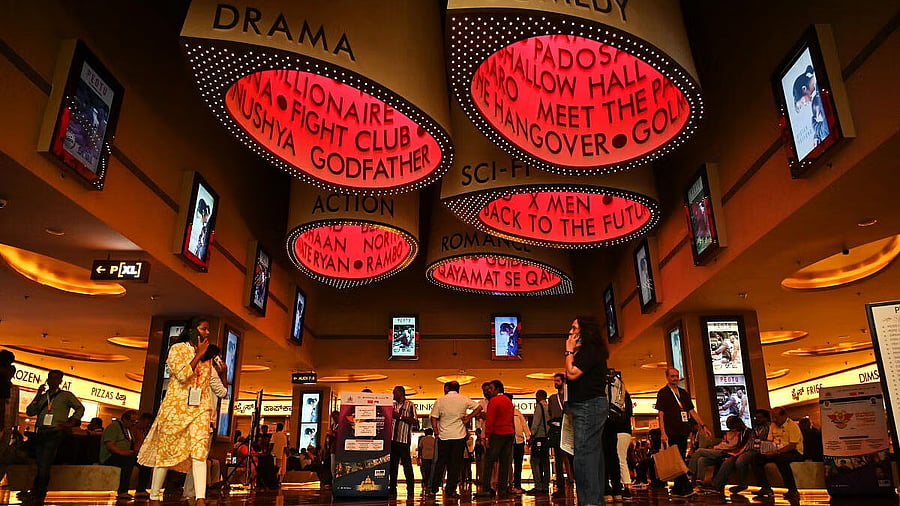
The 16th edition of BIFFes
Credit: DH Photo/Pushkar V
The 16th Bengaluru International Film Festival (BIFFes) at the Orion Mall was, without a doubt, a big draw. Cinephiles and the general public, old and young, thronged the multiplex for eight days to watch films unspooling across some 10 screens. The venue also served as a picnic spot for those who weren’t there solely for the films but enjoyed the experience—popcorn and other refreshments included.
Few seemed perturbed by Deputy Chief Minister D K Shivakumar’s fulminations against the film fraternity’s heavyweights for skipping the inaugural gala. Shivakumar’s warnings of how the government could tighten the “nuts and bolts” against the industry’s movers and shakers only served to underscore the case for keeping this state apparatus far from film festivals. It was grist to the mill of those who have always opposed film festivals being conducted as a government programme. The fact that state funds and support are necessary, and desirable, for such an international show does not mean that the government has to be its main organiser and conductor. The government’s role at best could be limited to that of a facilitator.
What is the need for a ‘political function’ with the predictable political ‘stars’ for declaring open a film festival? The absence of not only the Kannada film industry’s stars but also other sections shows that people who want to see a film, even the festival’s opening film, are loath to attend a political gala. In no way does this advance the cause of cinema or create a climate for film festivals. If the government is unwilling to give up control, the least it can do is conduct the inauguration in a way that interested sections feel motivated to attend.
The starting point of a festival where one feels welcome or put off is getting the passes. In the case of BIFFes, the issuing of passes to delegates, media, and others was well-managed, and media requirements were met adequately. Once past this threshold, the big question is how to make the most, in this case, of 200 films from 60 countries. Selection and scheduling of films is a critical test. Even the best of festivals with able organisers, an informed film community, and good intentions can get it wrong. The 16th BIFFes was no exception.
To take selection first, all the restored classics, but particularly Girish Kasaravalli’s Ghatashraddha, G Aravindan’s Thampu, and M S Sathyu’s Garam Hawa, were treats that struck a responsive chord at the festival. BIFFes did well to showcase, as homage, the films of icons such as M T Vasudevan Nair, Shyam Benegal, Dwarakish, Aparna Vastare, and Kumar Shahani. It is in handling the selection of the latest films that BIFFes may be said to have fallen short. Many of the films, not only the plethora of first films of directors, were way short of the mark in terms of theme, treatment, values, and aesthetics. Perhaps less emphasis on numbers (of countries and films) could have ensured the selection of a better crop of titles that measured up to ‘festival standard,’ although there can be no absolute definition of such a benchmark.
Many entries here had already been seen at other festivals and on platforms like Netflix and Amazon Prime. There could be stricter criteria for accepting some of these films, especially for competition. Festivals are also remembered for the ‘discovery’ of films, and BIFFes should strive to make the cut as the first place of screening.
Quality apart, there were many films, although from different countries, on the same theme or subject, such as migration, ‘love and longing’, ‘loss and leaving’, caregivers, returning to one’s roots, cultural conflicts, emotional and economic distress, and technology, including the Internet and AI. There is a clear case here for thematic filters to weed out the less than exceptional, avoid repetitions, and restrict the number by quality. Scheduling is no less a challenge. Many of the must-sees were shown in the same time slot on different screens. The number needs to be reduced to allow for more people to view more deserving films. The press conferences, discussions, and seminars at BIFFes were good, some even high value. The absence of a ‘lull’ in the schedule to enable attendance at events, as is the practice elsewhere, kept many away from engaging exchanges.
A multiplex may not be an appropriate venue for film festivals. With thousands flocking to so many screens in such a small enclosed space, it feels claustrophobic. There is a great need for an open space where people can hang around as they tend to do at film festivals—to reflect upon and process what they have seen.
Tailpiece: Does the festival’s signature film really need cut-out images of the Chief Minister and Deputy Chief Minister?
(The writer has been attending film festivals off and on for 40 years)